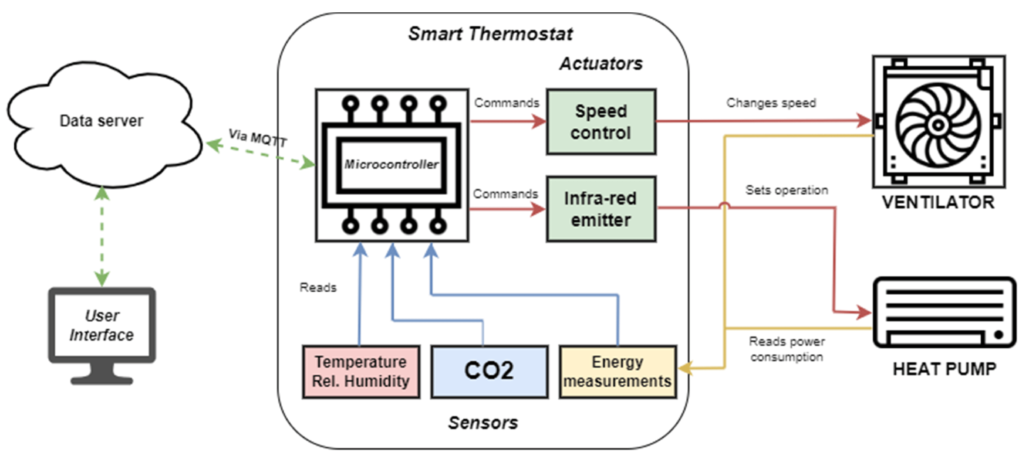Smart thermostats are one of the key innovations in home automation that significantly enhance comfort while simultaneously helping to reduce energy consumption. In this article, we will delve into how smart thermostats work, their benefits, and the best features to look for when considering one for your home.
What is a Smart Thermostat?
A smart thermostat is an intelligent device designed to regulate the temperature of your home based on your preferences and behavior. Unlike traditional thermostats that require manual adjustments, smart thermostats can learn your habits over time, adjusting the temperature automatically based on when you’re home, when you’re asleep, or even when you’re away. These devices connect to your home’s Wi-Fi network, enabling control through a smartphone app, smart speaker, or other voice-controlled devices. This connectivity makes it easy to manage the temperature of your home from anywhere, providing both convenience and energy efficiency.
How Smart Thermostats Work

The primary function of a smart thermostat is to control the heating, ventilation, and air conditioning (HVAC) system in your home. What sets smart thermostats apart is their ability to learn from your behavior and adapt over time. These devices typically use sensors, algorithms, and machine learning to optimize temperature settings.
Sensors and Learning Algorithms
Smart thermostats are equipped with temperature sensors that monitor the ambient temperature in different parts of the house. They also have occupancy sensors to determine when people are home. Based on this data, the thermostat adjusts the settings to ensure the house stays comfortable when you are around and conserves energy when you’re not. Over time, these devices learn your preferences for when you want the temperature to change, for example, cooling down the house just before you arrive home from work.
Remote Control and Integration
Another key feature of smart thermostats is their ability to connect to your Wi-Fi network, allowing you to control the temperature from anywhere via a smartphone app or through voice commands. Most models integrate with voice-controlled platforms like Amazon Alexa, Google Assistant, and Apple HomeKit, so you can change the temperature with a simple voice command. This remote control capability gives homeowners the flexibility to adjust the temperature on the go, ensuring they never return to a freezing or sweltering home again.
Geofencing and Scheduling
Many smart thermostats come with geofencing capabilities, which automatically adjust the temperature when you leave or enter a predefined geographic area. For instance, when you leave home, the thermostat will know to adjust the temperature to an energy-saving level. As you approach home, the thermostat will preemptively heat or cool the house to your desired temperature.
In addition to geofencing, smart thermostats also allow for advanced scheduling. You can set schedules based on your typical daily routine, like reducing the heat while you’re at work or increasing the cooling during the hottest part of the day. These features help ensure that your home is always at the right temperature when you need it while saving energy during times when comfort is not a priority.
Benefits of Smart Thermostats
Smart thermostats offer a variety of benefits that make them a valuable addition to any home, particularly for those who are looking to reduce energy costs, improve comfort, and streamline their daily routine.
1. Energy Savings
One of the most significant advantages of a smart thermostat is the potential for energy savings. Traditional thermostats are often set manually, leading to inefficient heating and cooling. A smart thermostat, however, automatically adjusts the temperature to match your lifestyle, ensuring that energy is not wasted when you’re away from home or asleep. According to studies, a smart thermostat can save homeowners anywhere between 10% to 23% annually on heating and cooling costs.
The ability to create schedules based on your routine and use geofencing also helps in reducing energy consumption. For example, a smart thermostat can ensure that your HVAC system isn’t running while no one is home or when the house is empty for several hours.
2. Convenience and Comfort
With a smart thermostat, gone are the days of manually adjusting your home’s temperature each time you enter or leave a room. Smart thermostats ensure your home remains at your preferred temperature, even when you’re not around. Thanks to their learning algorithms, these thermostats adapt to your habits over time, so you don’t have to worry about constantly reprogramming them. The ability to control the temperature remotely through an app or voice commands ensures maximum convenience.
3. Control at Your Fingertips
With the mobile app, you can control your thermostat from anywhere, whether you’re at work, on vacation, or simply relaxing in bed. You can make adjustments on the fly, ensuring you’re always in control of your home’s climate. This flexibility not only improves comfort but also enhances security. For example, if you’re away on vacation, you can remotely monitor and adjust the temperature, so your house is never left too hot or too cold for extended periods.
4. Integration with Other Smart Devices
Smart thermostats are often compatible with other smart home devices, such as smart lights, security systems, and voice assistants. For example, if your thermostat is integrated with a smart security system, it can sense when you’re not home and automatically adjust the temperature to energy-saving levels. Voice-controlled platforms like Amazon Alexa or Google Assistant make it easy to adjust the temperature with a simple voice command, even while cooking or relaxing on the couch.
5. Improved HVAC System Life Span
By optimizing temperature regulation, smart thermostats can prevent unnecessary strain on your HVAC system. This reduces wear and tear on the system, extending its life span and potentially saving you money on expensive repairs or replacements.
Features to Look for in a Smart Thermostat
When considering a smart thermostat for your home, it’s essential to choose a model with the features that best suit your needs. Below are some key features to look for when shopping for a smart thermostat:
1. Learning Capabilities
Look for a thermostat that learns your schedule and preferences over time. Many smart thermostats, such as the Nest Learning Thermostat, automatically adjust based on your behavior, ensuring that your home is always at the right temperature without you having to reprogram it.
2. Geofencing
Geofencing allows the thermostat to detect when you’re away from home and adjust the temperature accordingly. This feature ensures that you’re not wasting energy heating or cooling an empty house.
3. Remote Control
The ability to control your thermostat remotely is crucial for many homeowners. Ensure the thermostat you choose has a smartphone app that allows for remote adjustments, even when you’re not at home.
4. Compatibility with Voice Assistants
Many smart thermostats are compatible with voice-controlled devices like Amazon Alexa, Google Assistant, or Apple HomeKit. If you prefer hands-free control, look for a thermostat that integrates with your preferred voice assistant.
5. Integration with Other Smart Devices
For a fully integrated smart home experience, consider a thermostat that works well with other smart devices like smart lights, security cameras, or smart locks. This allows you to create routines that enhance your overall home automation system.
6. Energy Usage Reports
Some smart thermostats provide detailed reports on your energy usage, helping you understand how much you’re saving and where you can further optimize your heating and cooling habits.
Popular Smart Thermostat Models
1. Nest Learning Thermostat (3rd Gen)
The Nest Learning Thermostat is one of the most popular models on the market, known for its intuitive design and ease of use. It learns your temperature preferences over time and adjusts your home’s climate accordingly. It also integrates seamlessly with Google Assistant and Alexa.
2. Ecobee SmartThermostat
The Ecobee SmartThermostat offers many advanced features, including an easy-to-use touchscreen, voice control via Alexa, and remote sensors to optimize comfort in multiple rooms. It also provides energy usage reports, helping you monitor your savings.
3. Honeywell Home T9
Honeywell’s T9 Smart Thermostat comes with remote sensors for room-by-room temperature control, ensuring your home stays comfortable no matter where you are. It is compatible with Alexa and Google Assistant and provides detailed energy reports.
Conclusion
Smart thermostats offer a wide range of benefits, from energy savings to improved convenience and comfort. They are a valuable investment for anyone looking to optimize their home’s climate control while reducing energy consumption. Whether you’re interested in the learning capabilities of the Nest, the geofencing features of Ecobee, or the room-by-room temperature control of Honeywell, there is a smart thermostat to suit every home and lifestyle. By making the switch to a smart thermostat, you can take control of your home’s energy usage and enjoy a more comfortable living environment, all while saving money in the long run.

